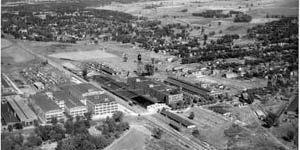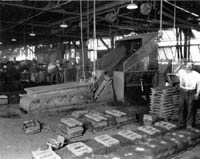Spreader Works
John Deere's name rightfully leads all others on the muster of pioneer craftsmen whose vision laid the foundations for Deere & Co., for even in that select group he is outstanding. Yet the others must not be ignored, for their contributions to easier, more profitable farming were great. Among them is Augustus Adams, who in 1859 invented a force-feed automatic corn sheller, and Joseph Kemp, who in 1878 made the first practical manure spreader.
 Meanwhile, the the little town of Marseilles, on the Illinois River, was gaining attention throughout the Corn Belt, for it was there that Augustus Adams and several of his sons had started a factory to manufacture the implement which he invented. A little later Marseilles gained further attention, when the sheller factory was expanded to manufacture another agricultural labor-saver, one of the first successful grain elevators.
Meanwhile, the the little town of Marseilles, on the Illinois River, was gaining attention throughout the Corn Belt, for it was there that Augustus Adams and several of his sons had started a factory to manufacture the implement which he invented. A little later Marseilles gained further attention, when the sheller factory was expanded to manufacture another agricultural labor-saver, one of the first successful grain elevators.
In 1881, the Kemp & Burpee Manufacturing Co. was organized in Syracuse, N. Y., to build and market the first practical manure spreader. Before Joseph Kemp invented this implement, the only way a farmer could distribute manure to maintain soil fertility was to hand-load it in a wagon, drive to the field, and spread it with a pitchfork.
In 1908, Deere & Co. purchased the Marseilles sheller and elevator factory and business. Two years later, demand for the Marseilles products had become so great that a new factory was needed. It was built in East Moline, Ill. At about that time, too, the Deere & Co. merger of 1911 was being effected, and the Kemp & Burpee Manufacturing Co. was taken into the John Deere organization. The decision was made to build the Kemp & Burpee spreader, known as the "Success" spreader, at the Marseilles plant in East Moline.
 Although the "Success" spreader was a much better implement than Joseph Kemp's first model, no major improvement had been made for thirty years. But when the first John Deere spreader was ready for trial, in 1912, it not only used the best of Kemp's ideas, but embodied the "beater on the axle" principle, an improvement very close in importance to invention of the spreader itself. Tests were successful, and acceptance was so enthusiastic that by the end of the year 23,000 John Deere spreaders had been produced.
Although the "Success" spreader was a much better implement than Joseph Kemp's first model, no major improvement had been made for thirty years. But when the first John Deere spreader was ready for trial, in 1912, it not only used the best of Kemp's ideas, but embodied the "beater on the axle" principle, an improvement very close in importance to invention of the spreader itself. Tests were successful, and acceptance was so enthusiastic that by the end of the year 23,000 John Deere spreaders had been produced.
The East Moline factory, which was built to make Marseilles shellers and elevators, and Kemp spreaders, was later renamed the John Deere Spreader Works, and its products included not only shellers, spreaders, and portable grain elevators, but manure loaders, hammer and roughage mills, and cotton harvesters.
Copyright© 2003 Deere & Company Archives
